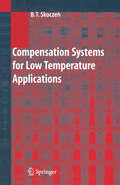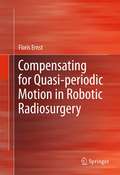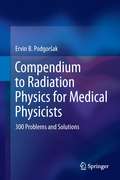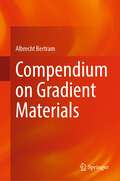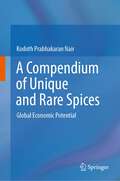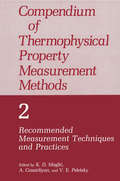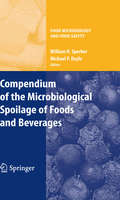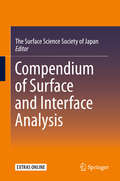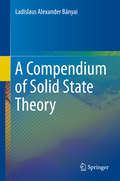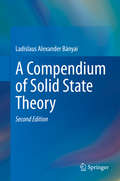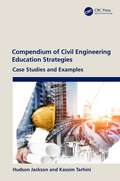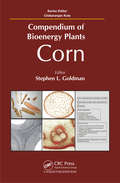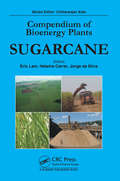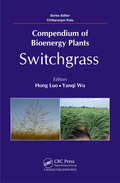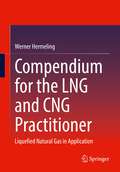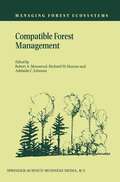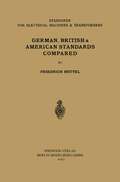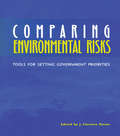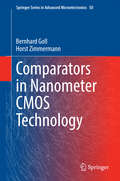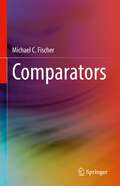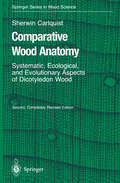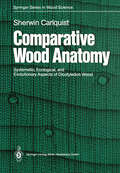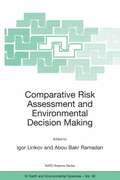- Table View
- List View
Compensation Systems for Low Temperature Applications
by Balzej T. SkoczenThe present monograph is mainly focused on the behaviour of ductile ma terials at cryogenic temperatures, stability issues concerning application of corrugated shells at cryogenic conditions and reliability oriented parametric optimisation of compensation systems containing the corrugated bellows. As there are relatively few publications on combined material and structural be haviour at very low temperatures, the monograph aims at filling this gap. It is worth pointing out that within the class of publications dedicated to low temperature behaviour of materials and structures the majority is based on testing down to the temperature of liquid nitrogen (77 K). Rare publications deal with the analysis of material and structural response at the temperature of liquid helium (4. 5 K) or superfluid helium (below the point T>. , = 2. 17 K). This can be explained by the fact that an (by its nature complex) installation for testing at such low temperatures is very expensive. Only the large research centres and universities, working in the domain of superconductivity, cryogen ics or developing superconducting magnets for particle accelerators, can afford such installations. A significant part of the present monograph is dedicated to the analy sis of the phenomena associated with plastic yielding in stainless steels at cryogenic temperatures. Generally, three phenomena are distinguished: plas tic strain induced phase transformations, serrated yielding and evolution of ductile damage.
Compensating for Quasi-periodic Motion in Robotic Radiosurgery
by Floris ErnstCompensating for Quasi-periodic Motion in Robotic Radiosurgery outlines the techniques needed to accurately track and compensate for respiratory and pulsatory motion during robotic radiosurgery. The algorithms presented within the book aid in the treatment of tumors that move during respiration. In Chapters 1 and 2, the book introduces the concept of stereotactic body radiation therapy, motion compensation strategies and the clinical state-of-the-art. In Chapters 3 through 5, the author describes and evaluates new methods for motion prediction, for correlating external motion to internal organ motion, and for the evaluation of these algorithms’ output based on an unprecedented amount of real clinical data. Finally, Chapter 6 provides a brief introduction into currently investigated, open questions and further fields of research. Compensating for Quasi-periodic Motion in Robotic Radiosurgery targets researchers working in the related fields of surgical oncology, artificial intelligence, robotics and more. Advanced-level students will also find this book valuable.
Compendium to Radiation Physics for Medical Physicists: 300 Problems and Solutions
by Ervin B. PodgorsakThis exercise book contains 300 typical problems and exercises in modern physics and radiation physics with complete solutions, detailed equations and graphs. This textbook is linked directly with the textbook "Radiation Physics for Medical Physicists", Springer (2010) but can also be used in combination with other related textbooks. For ease of use, this textbook has exactly the same organizational layout (14 chapters, 128 sections) as the "Radiation Physics for Medical Physicists" textbook and each section is covered by at least one problem with solution given. Equations, figures and tables are cross-referenced between the two books. It is the only large compilation of textbook material and associated solved problems in medical physics, radiation physics, and biophysics.
Compendium on Gradient Materials
by Albrecht BertramThis book offers frameworks for the material modeling of gradient materials both for finite and small deformations within elasticity, plasticity, viscosity, and thermomechanics. The first chapter focuses on balance laws and holds for all gradient materials. The next chapters are dedicated to the material modeling of second and third-order materials under finite deformations. Afterwards the scope is limited to the geometrically linear theory, i.e., to small deformations. The next chapter offers an extension of the concept of internal constraints to gradient materials. The final chapter is dedicated to incompressible viscous gradient fluids with the intention to describe, among other applications, turbulent flows, as already suggested by Saint-Venant in the middle of the 19th century.
A Compendium of Unique and Rare Spices: Global Economic Potential
by Kodoth Prabhakaran NairThis book is a compendium of rare and unique spices, which have been least researched but hold immense economic potential on a global scale. They are Aniseed, Shallot, Saffron, Caraway or Siah Zira, European or Indian Dill, Poppy, Star Anise and Japanese Star Anise, Sage, Savory, Tarragon, Thyme, Calamus or Sweet Flag, Horse Radish, Galangal, and Long Pepper or Pipli. Some of these are seed spices and others, like Saffron, are grown in the hills of Jammu and Srinagar, India and have varied uses, ranging from being very popular food flavorants to being used for religious purposes. Even within India, the country of the origin for most of the spices listed, many Indians are simply unaware of their immense economic potential. This is also the case with other countries, like Iran, where some spices, like Saffron, is widely used as a food flavorant. The book aims to be a unique compendium of these rare and unique spices to primarily enable researchers to tap into their great economic potential and, on a wider scale, help developmental agencies to tap into their immense potential in global spice trade. The book provides a cross-sectoral multi-scale assessment of developmental possibilities, globally, for rare and unique spices of immense economic importance.
Compendium of Thermophysical Property Measurement Methods: Volume 2 Recommended Measurement Techniques and Practices
by A. Cezairliyan K. D. Maglic V. E. PeletskyBuilding on the extensive coverage of the first volume, Volume 2 focuses on the fundamentals of measurements and computational techniques that will aid researchers in the construction and use of measurement devices.
Compendium of the Microbiological Spoilage of Foods and Beverages (Food Microbiology and Food Safety)
by Michael P. DoyleThe increased emphasis on food safety during the past two decades has decreased the emphasis on the loss of food through spoilage, particularly in developed co- tries where food is more abundant. In these countries spoilage is a commercial issue that affects the pro?t or loss of producers and manufacturers. In lesser developed countries spoilage continues to be a major concern. The amount of food lost to spoilage is not known. As will be evident in this text, stability and the type of spoilage are in?uenced by the inherent properties of the food and many other factors. During the Second World War a major effort was given to developing the te- nologies needed to ship foods to different regions of the world without spoilage. The food was essential to the military and to populations in countries that could not provide for themselves. Since then, progress has been made in improved product formulations, processing, packaging, and distribution systems. New products have continued to evolve, but for many new perishable foods product stability continues to be a limiting factor. Many new products have failed to reach the marketplace because of spoilage issues.
Compendium of Surface and Interface Analysis
by The Surface Science Society of JapanThis book concisely illustrates the techniques of major surface analysis and their applications to a few key examples.Surfaces play crucial roles in various interfacial processes, and their electronic/geometric structures rule the physical/chemical properties. In the last several decades, various techniques for surface analysis have been developed in conjunction with advances in optics, electronics, and quantum beams. This book provides a useful resource for a wide range of scientists and engineers from students to professionals in understanding the main points of each technique, such as principles, capabilities and requirements, at a glance. It is a contemporary encyclopedia for selecting the appropriate method depending on the reader's purpose.
A Compendium of Solid State Theory
by Ladislaus Alexander BányaiDesigned to sit alongside more conventional established condensed matter physics textbooks, this compact volume offers a concise presentation of the principles of solid state theory, ideal for advanced students and researchers requiring an overview or a quick refresher on a specific topic.The book starts from the one-electron theory of solid state physics, moving through electron-electron interaction and many-body approximation schemes, to lattice oscillations and their interactions with electrons. Subsequent chapters discuss transport theory and optical properties, phase transitions and some properties of low-dimensional semiconductors. Throughout the text, mathematical proofs are often only sketched, and the final chapter of the book reviews some of the key concepts and formulae used in theoretical physics.Aimed primarily at graduate and advanced undergraduate students taking courses on condensed matter theory, the book serves as a study guide to reinforce concepts learned through conventional solid state texts. Researchers and lecturers will also find it a useful resource as a concise set of notes on fundamental topics.
A Compendium of Solid State Theory
by Ladislaus Alexander BányaiDesigned to sit alongside more conventional established condensed matter physics textbooks, this compact volume offers a concise presentation of the principles of solid state theory, ideal for advanced students and researchers requiring an overview or a quick refresher on a specific topic.The book starts from the one-electron theory of solid state physics, moving through electron-electron interaction and many-body approximation schemes, to lattice oscillations and their interactions with electrons. Subsequent chapters discuss transport theory and optical properties, phase transitions and some properties of low-dimensional semiconductors. This extensively expanded second edition includes new material on adiabatic perturbation theory, kinetic coefficients, the Nyquist theorem, Bose condensation, and the field-theoretical approach to non-relativistic quantum electrodynamics. Throughout the text, mathematical proofs are often only sketched, and the final chapter of the book reviews some of the key concepts and formulae used in theoretical physics.Aimed primarily at graduate and advanced undergraduate students taking courses on condensed matter theory, the book serves as a study guide to reinforce concepts learned through conventional solid state texts. Researchers and lecturers will also find it a useful resource as a concise set of notes on fundamental topics.
Compendium of Civil Engineering Education Strategies: Case Studies and Examples
by Hudson Jackson Kassim TarhiniThis book compiles the latest strategies and information regarding civil engineering education, and the skills necessary for success that are tangential to engineering, including global perspectives, critical and design thinking skills, leadership skills, assessment, recruitment, retention, and more. It is designed so that each chapter can be used separately or in combination with other chapters to help enhance and foster student learning as well as promote the development of skills required for engineering practice. Features Includes overviews of successful academic approaches for each topic including implementation examples in every chapter Explains how assessment and the resulting data can be used for holistic evaluation and improvement of student learning Addresses the complexities of moral and professional ethics in engineering Highlights the importance of adopting a global perspective and the successful strategies that have been used or considered in educating resilient, globally minded engineers Compendium of Civil Engineering Education Strategies: Case Studies and Examples serves as a useful guide for engineering faculty, practitioners, and graduate students considering a career in academia. Academic faculty and working professionals will find the content helpful as instructional and reference material in developing and assessing career skills. It is also useful for intellectually curious students who want a deeper understanding and appreciation of the need for professional development and life-long learning.
Compendium of Civil Engineering Education Strategies: Case Studies and Examples
by Hudson Jackson Kassim TarhiniThis book compiles the latest strategies and information regarding civil engineering education, and the skills necessary for success that are tangential to engineering, including global perspectives, critical and design thinking skills, leadership skills, assessment, recruitment, retention, and more. It is designed so that each chapter can be used separately or in combination with other chapters to help enhance and foster student learning as well as promote the development of skills required for engineering practice. Features Includes overviews of successful academic approaches for each topic including implementation examples in every chapter Explains how assessment and the resulting data can be used for holistic evaluation and improvement of student learning Addresses the complexities of moral and professional ethics in engineering Highlights the importance of adopting a global perspective and the successful strategies that have been used or considered in educating resilient, globally minded engineers Compendium of Civil Engineering Education Strategies: Case Studies and Examples serves as a useful guide for engineering faculty, practitioners, and graduate students considering a career in academia. Academic faculty and working professionals will find the content helpful as instructional and reference material in developing and assessing career skills. It is also useful for intellectually curious students who want a deeper understanding and appreciation of the need for professional development and life-long learning.
Compendium of Bioenergy Plants: Corn
by Stephen L. Goldman Chittaranjan KoleThis book evaluates maize as a bioenergy fuel source from two perspectives. It explores whether the input energy needed to generate fuel significantly exceeded by the energy harvested. In examining this issue, the chapters provide assessments of the social, economic, and political impact on fuel pricing, food costs, and the environmental challenge
Compendium of Bioenergy Plants: Sugarcane
by Eric Lam Helaine Carrer Jorge A. Da Silva Chittaranjan KoleThis volume of the Bioenergy Plants compendium contains a collection of chapters that focus on the history, economics, and practical sciences related to sugarcane. As one of the key biofuel crops in the world that is under large-scale cultivation, sugarcane is attracting interests for its adoption and emulation worldwide. With a high ratio of energ
Compendium of Bioenergy Plants: Switchgrass
by Hong Luo Yanqi Wu Chittaranjan KoleThis book contains the most comprehensive reviews on the latest development of switchgrass research including the agronomy of the plant, the use of endophytes and mycorrhizae for biomass production, genetics and breeding of bioenergy related traits, molecular genetics and molecular breeding, genomics, transgenics, processing, bioconversion, biosyst
Compendium for the LNG and CNG Practitioner: Liquefied Natural Gas in Application
by Werner HermelingThe most important physical principles as well as the engineering equipment (components, assemblies as well as their function) for the regasification and compression of cryogenic liquefied gases (incl. biogas / methane from recent sources) are presented in this book. Practical advice is given on possible plant layout and design. Safety-related as well as product-specific designs are pointed out and their solutions are described. The book contains numerous references and summaries. The author is an engineer of chemical plant engineering as well as heat, ventilation and air conditioning technology with many years of practical experience in the field of cryogenic liquefied gases, their transport, regasification and compression. He is the inventor of several patented and implemented solutions. This book is addressed to safety officers, plant operators, employees in direct contact with such plants as well as decision makers and approving authorities.
Compatible Forest Management (Managing Forest Ecosystems #8)
by Robert A. Monserud Richard W. Haynes Adelaide C. JohnsonPublic debate has stimulated interest in finding greater compatibility among forest management regimes. The debate has often portrayed management choices as tradeoffs between biophysical and socioeconomic components of ecosystems. Here we focus on specific management strategies and emphasize broad goals such as biodiversity, wood production and habitat conservation while maintaining other values from forestlands desired by the public. We examine the following proposition: Commodity production (timber, nontimber forest products) and the other forest values (biodiversity, fish and wildlife habitat) can be simultaneously produced from the same area in a socially acceptable manner. Based on recent research in the Pacific Northwest, we show there are alternatives for managing forest ecosystems that avoid the divisive arena of 'either-or' choices. Much of the work discussed in this book addresses two aspects of the compatibility issue. First, how are various forest management practices related to an array of associated goods and services? Second, how do different approaches to forest management affect relatively large and complex ecosystems?
Comparison of Principal Points of Standards for Electrical Machinery (Rotating Machines and Transformers)
by Freidrich NettelComparing Environmental Risks: Tools for Setting Government Priorities
by J. Clarence DaviesThe budgetary squeeze of the 1990s has made it obvious that the government cannot address every possible environmental problem. Comparative risk assessment (CRA) is increasingly advanced as the means for setting realistic priorities. RFF's Center for Risk Management commissioned background papers from leading experts on CRA for a meeting with federal regulatory officials. Comparing Environmental Risks presents the revised papers of this workshop. Representing the state of the art on programmatic CRA, its methodological analyses and practical recommendations will be invaluable to government officials, independent analysts, and anyone studying environmental policy.
Comparing Environmental Risks: Tools for Setting Government Priorities
by J. Clarence DaviesThe budgetary squeeze of the 1990s has made it obvious that the government cannot address every possible environmental problem. Comparative risk assessment (CRA) is increasingly advanced as the means for setting realistic priorities. RFF's Center for Risk Management commissioned background papers from leading experts on CRA for a meeting with federal regulatory officials. Comparing Environmental Risks presents the revised papers of this workshop. Representing the state of the art on programmatic CRA, its methodological analyses and practical recommendations will be invaluable to government officials, independent analysts, and anyone studying environmental policy.
Comparators in Nanometer CMOS Technology (Springer Series in Advanced Microelectronics #50)
by Bernhard Goll Horst ZimmermannThis book covers the complete spectrum of the fundamentals of clocked, regenerative comparators, their state-of-the-art, advanced CMOS technologies, innovative comparators inclusive circuit aspects, their characterization and properties. Starting from the basics of comparators and the transistor characteristics in nanometer CMOS, seven high-performance comparators developed by the authors in 120nm and 65nm CMOS are described extensively. Methods and measurement circuits for the characterization of advanced comparators are introduced. A synthesis of the largely differing aspects of demands on modern comparators and the properties of devices being available in nanometer CMOS, which are posed by the so-called nanometer hell of physics, is accomplished. The book summarizes the state of the art in integrated comparators. Advanced measurement circuits for characterization will be introduced as well as the method of characterization by bit-error analysis usually being used for characterization of optical receivers. The book is compact, and the graphical quality of the illustrations is outstanding. This book is written for engineers and researchers in industry as well as scientists and Ph.D students at universities. It is also recommendable to graduate students specializing on nanoelectronics and microelectronics or circuit design.
Comparators
by Michael C. FischerThis book explores circuit designs that accomplish the conversion of an analog signal to a digital signal of a single bit. Starting with the simple comparator, many alternative circuit arrangements and enhancements are elaborated, including hysteresis, negative feedback and a variety of adaptive thresholds. Further, the non-ideal behavior of practical elements and circuits are covered, including input offsets, noise, delay, delay dispersion and oscillation, along with techniques for dealing with these aspects. The wide variety of available components is discussed in terms of performance and applicability. No stone is left unturned in addressing each and every issue that can affect the engineering tasks related to comparators, from the viewpoint of how their performance can affect the system in which they are a critical component.
Comparative Wood Anatomy: Systematic, Ecological, and Evolutionary Aspects of Dicotyledon Wood (Springer Series in Wood Science)
by Sherwin CarlquistThis second edition has been completely revised and has incorporated significant changes that have occurred in wood anatomy over the past years. "This book is recommended to all who are interested in a modern, stimulating, competent, and well illustrated work." (Holzforschung).
Comparative Wood Anatomy: Systematic, Ecological, and Evolutionary Aspects of Dicotyledon Wood (Springer Series in Wood Science)
by Sherwin CarlquistThis second edition has been completely revised and has incorporated significant changes that have occurred in wood anatomy over the past years. "This book is recommended to all who are interested in a modern, stimulating, competent, and well illustrated work." (Holzforschung).
Comparative Risk Assessment and Environmental Decision Making (Nato Science Series: IV: #38)
by Igor Linkov Abou Bakr RamadanDecision making in environmental projects is typically a complex and confusing process characterized by trade-offs between socio-political, environmental, and economic impacts. Comparative Risk Assessment (CRA) is a methodology applied to facilitate decision making when various activities compete for limited resources. CRA has become an increasingly accepted research tool and has helped to characterize environmental profiles and priorities on the regional and national level. CRA may be considered as part of the more general but as yet quite academic field of multi-criteria decision analysis (MCDA). Considerable research in the area of MCDA has made available methods for applying scientific decision theoretical approaches to multi-criteria problems, but its applications, especially in environmental areas, are still limited. The papers show that the use of comparative risk assessment can provide the scientific basis for environmentally sound and cost-efficient policies, strategies, and solutions to our environmental challenges.
